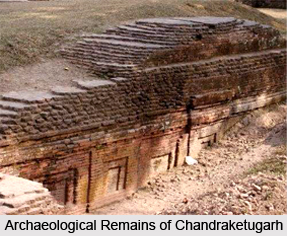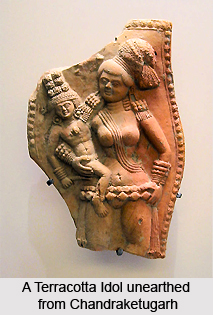 Chandraketugarh is an ancient city of Bengal situated alongside Vidyadhari River, at a distance of nearly 35 km from the north-eastern portion of Kolkata, in North 24 Parganas District(West Bengal). It is close to Berachampa town and the railway station of Haroa Road. Excavations which have been conducted by the Archaeological Survey of India since several years have enabled the discovery of numerous historical relics belonging to various ages. Some historians have asserted that Chandraketugarh is also known as `Gangaridai` to some Roman and Green authors. It is believed that the region of Chandraketugarh has been named to honour a mythical king named `Chandraketu`. Ashutosh Museum of Calcutta University had organised excavations at this historical area during 1955 to 1956 and 1965 to 1966 and unearthed old artefacts dating back to the periods of pre-Mauryan and pre-Pala cultures.
Chandraketugarh is an ancient city of Bengal situated alongside Vidyadhari River, at a distance of nearly 35 km from the north-eastern portion of Kolkata, in North 24 Parganas District(West Bengal). It is close to Berachampa town and the railway station of Haroa Road. Excavations which have been conducted by the Archaeological Survey of India since several years have enabled the discovery of numerous historical relics belonging to various ages. Some historians have asserted that Chandraketugarh is also known as `Gangaridai` to some Roman and Green authors. It is believed that the region of Chandraketugarh has been named to honour a mythical king named `Chandraketu`. Ashutosh Museum of Calcutta University had organised excavations at this historical area during 1955 to 1956 and 1965 to 1966 and unearthed old artefacts dating back to the periods of pre-Mauryan and pre-Pala cultures.
History of Chandraketugarh
Chandraketugarh is as old as the 3rd century B.C, which constitutes the period much prior to the Mauryan era. The relics discovered from this site have revealed that Chandraketugarh witnessed the settlement of numerable inhabitants during Sunga-Kushana period, followed by the Gupta age and eventually the age of Pala-Sena. Such discoveries indicate that Chandraketugarh was a significant urban spot, where trade and commercial activities flourished, and that it was an important port city. A high, encircled wall, along with a moat and rampart are existent at this region. The religion followed by the then residents of this renowned historical site is shrouded in mystery, though the presence of certain religious cults has been noticed in some of the artefacts. Inscriptions in Brahmi and Kharosthi scripts have been found on some potteries unearthed here.

Geography of Chandraketugarh
Chandraketugarh is present in North 24 Parganas and falls under the jurisdiction of the Police Station of Deganga. It includes the areas like Hadipur, Ghaziatala, Ghorapota, Chuprijhara, Dhanpota, Berachampa, Shanpukur, Jhikra, Ranakhola, Mathbari, Singer Ati and Deulia (Debalaya). The most interesting archaeological specimens exist in the southern part of Berachampa which is a seven-mile long road. Chandraketugarh is located within a belt of fertile alluvial delta, at a region where rivers constantly alter their courses. Therefore, the exact geographical features of this area are unknown. It is based at a distance of 10 km from the northern portion of Vidyadhari River. Once, many centuries ago, Vidyadhari River was connected to the Adi Ganga River, which was the ancient path of Ganga River. It was with the aide of this route that Chandraketugarh enjoyed an easy access to the sea.
Archaeological Artefacts at Chandraketugarh
Chandraketugarh boasts of some of the most magnificent instances of the art of terracotta. Innumerable terracotta plaques are found here, which might thrill visitors through their excellent forms of craftsmanship. These beautiful plaques bear a similar resemblance to those discovered in Ahichhatra and Kaushambi. Gold coins and silver-punched coins, semi-precious stone beads, objects made of bone and ivory and wooden artefacts which display remarkable sculpture are amongst the various kinds of archaeological remnants and artefacts found at this area.
The terracotta figurines belong to the period of the Mauryas, Sunga Dynasty, Gupta Dynasty and as well as the Kushana Dynasty. Other things like clay pipes, drainage systems, minted copper coins, ivory bangles and beads, bronze objects have also been found. A 45 sq km sized prayer hall was also discovered that dates back to 700-600 BC and Kharosthi script of 600-400 BC. Chandraketugarh comprises the remains of a temple and a palace. Northern Black Polished Ware and other wares have also been discovered. The `Khana-Mihireri Dhipi` is a famous archaeological site present at Chandraketugarh.
Visiting Information
Chandraketugarh is based about 50 km from the city of Kolkata and can be approached by road, by passing through Barasat. It takes about 2 hours to reach this place. Buses are easily available from Esplanade and Ultadanga, which can be utilized to reach Berachampa. One can have an easy access to Chandraketugarh form Berachampa.



















